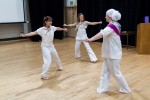The buzuq twangs, the tapan beats and Sevi Bayraktar lets out a joyous zilgit that pierces the air.
The zilgit, a shrill Kurdish cry, expresses the feelings of the female dancers of Asia Minor.
A group of UCLA students will perform “Dancing Asia Minor,” as part of the Fowler Out Loud series, in the Fowler Museum courtyard on Thursday at 6 p.m. A collaborative project designed to highlight the diversity in music and dance from the area, the performance accompanies photographs from the Fowler Museum’s current exhibit “Round Trip: Bicycling Asia Minor, 1891.”
Co-created by Alyssa Mathias, a graduate student in ethnomusicology, and Sevi Bayraktar, a graduate student in world arts and cultures/dance, “Dancing Asia Minor” showcases music from Greece, Turkey, Armenia, Iran and Mesopotamia and aims to celebrate the cultural interaction between the countries, Bayraktar said.
Midway through fall quarter, after hearing of the upcoming exhibition at the Fowler Museum, Mathias and Bayraktar came up with the idea of embarking on a creative project using their common interests of music and dance from Asia Minor.
“Our first thought was to reflect the exhibition in order to reproduce it,” Bayraktar said. “But then we noticed that there are some forgotten figures; for example, the women that you can see in the photographs.”
The pair then decided to create a performance through the eyes of modern women from Asia Minor so that the stories of their 19th-century counterparts could finally be heard, Mathias said.
“We can’t speak for the women in those photographs, but we can suggest certain ways that their stories might have been told,” Mathias said.
The project brings together students and professors from different parts of UCLA who have knowledge and enthusiasm for the music and dance of Asia Minor.
Mathias said they received help from Esti Kenan-Ofri, a visiting professor in the ethnomusicology department. She brought a rare Sephardi song, passed down through generations by word-of-mouth and from a friend in the mathematics department who helped with the Mesopotamian and Kurdish dances.
Mathias said she thought finding musicians able to play the required instruments would be the most difficult part. However, she said she was able to recruit students from the Near East Ensemble, the Music and Dance Balkans Ensemble and the Early Music Ensemble to form a six-piece group to accompany the dancers.
The instruments in “Dancing Asia Minor” include the tapan – a large goat skin-covered drum – and the buzuq, which fourth-year ethnomusicology student Ryan Vig said was like a large mandolin with a tinny, metal string sound.
“Vig and (fourth-year ethnomusicology student) Ziyad Marcus are playing so many different kinds of instruments, so many different styles, learning so much new music for this and doing it all with a smile and genuine interest,” Mathias said. “This would not be possible without that kind of enthusiasm.”
The dancing for the performance fuses traditional with improvisational. The repertoire goes from the hasaposerviko – a Greek dance – to Iranian music that Bayraktar and a fellow professional dancing partner have coupled with steps, gestures and body postures from Turkey, Syria and Iran to create an improvised Mesopotamian melange.
Bayraktar, a Turkish citizen, said that for her, the performance is partly about educating the audience on her own country’s culture and that of the other countries in Asia Minor.
“We will dance an avant-garde, contemporary duo, and we will try to break down some of the stereotypes of Orientalism and some Orientalist images of women,” Bayraktar said. “It’s a celebration of our human creativity by shifting locations, while interacting with each other and each other’s cultures.”
Mathias said she shares her friend’s desire to raise questions about the traditions and cultures that are portrayed in “Dancing Asia Minor,” which she said she believes are often misrepresented and misunderstood.
“(Women from the Asia Minor) have been victim to people speaking over them or speaking for them in so many different ways,” Mathias said.
Mathias said the main difficulty with the project is to make sure not to repeat the errors of the past, and instead give a beautiful, candid expression of how the women of Asia Minor feel.
“We’re not looking at it with rose-colored glasses,” Mathias said. “We’re trying to do something that is historically and artistically informed that might speak to the issues we want to raise.”
